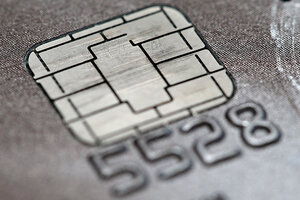Chip-enabled cards prompt decline in counterfeit charges, Visa says
As chip-enabled cards enter the market, some merchants are reporting fewer fraudulent transactions. Making purchases with the cards is set to speed up, as well.

A chip-embedded credit card.
Matt Rourke/AP/File
Visa, the world's largest payments network, says its switch to chip-enabled cards is beginning to pay off in transaction security.
Of the 25 merchants that reported suspicious activities in 2014, five began using machines that process chip-enabled cards, and saw fraudulent activities decline by 18.3 percent, a Visa representative told USA Today. Five of the merchants that chose not to switch, on the other hand, reported an 11.4 percent surge in fraudulent transactions.
EMV cards – that's short for Europay, MasterCard, and Visa, the companies that created the standard – are considered safer than those with only magnetic strips. Hackers may still have the ability to steal information from payment systems, but the stolen information won't be of any use, because the chip assigns a unique code to each transactions. Chip cards' safety is also greater because they are difficult to duplicate, unlike magnetic cards.
The only major drawback to EMV is that the chip readers tend to be much slower than the magnetic-stripe readers. But that could soon change.
In response to complaints about the waiting periods caused by new chip-enabled credit and debit cards, Visa Inc. is unveiling a new Quick Chip for EMV that will require only a few seconds to complete transactions. The company said that the Quick Chip will take customers a second or two.
"The key difference will be you can insert your card, leave it in the terminal for a split second and remove the card rather quickly, rather than waiting for the entire transaction to complete" Stephanie Ericksen, Visa's vice president of risk products, told Bloomberg.
The overall transaction time will be reduced by only a few seconds, but for impatient customers, that could make a difference. "Leaving your card in the terminal makes it feel longer," Ms. Ericksen told USA Today. "We wanted to work on ways to make it, from a consumer experience perspective, and from the merchant perspective, a lot more seamless."
The difference is more than psychological. Even an extra 8 to 12 seconds per checkout could increase labor costs by $3.2 million, according to a study conducted by JDA Software Group.
The industry's initially slow transition to chip-enabled cards is now picking up pace: Visa alone has issued 265 million chip-enabled debit and credit cards in the United States, making it the largest chip-card market in the world, although other countries jumped on board well before the US.
In order to speed up transactions, however, merchants will have to activate the new readers. As of January 2016, only 37 percent of companies in a survey by The Strawhecker Group, a payments consulting firm, estimated that their merchants were almost ready to roll out the readers; 72 percent believed they would be ready by December 2016.
Many of those who are delaying the switch could be small operations, payment analyst Alan Weinberg suggested in a blog post for Glenbook, another payments consulting firm:
Almost every new terminal deployed these days is EMV-enabled, but the millions and millions of terminals at "mom and pop merchants" have a very long useful life – 7 years gets quoted quite often. Why incur the expense and hassle of upgrading when you are highly unlikely to ever see a counterfeit card? I don’t think the local dry cleaner, daycare center, or dog groomer is particularly worried.

